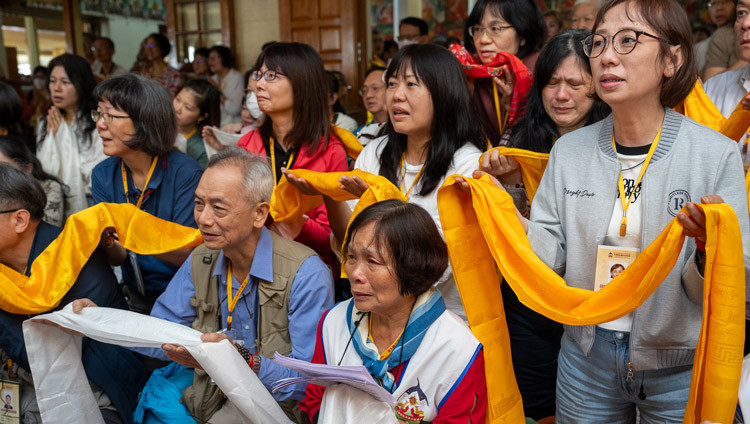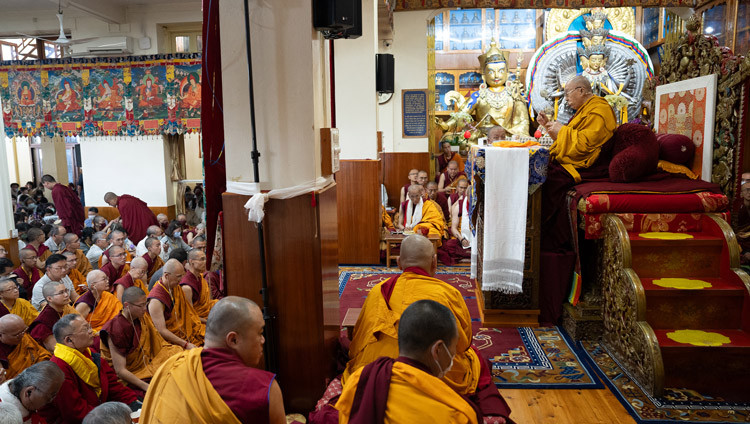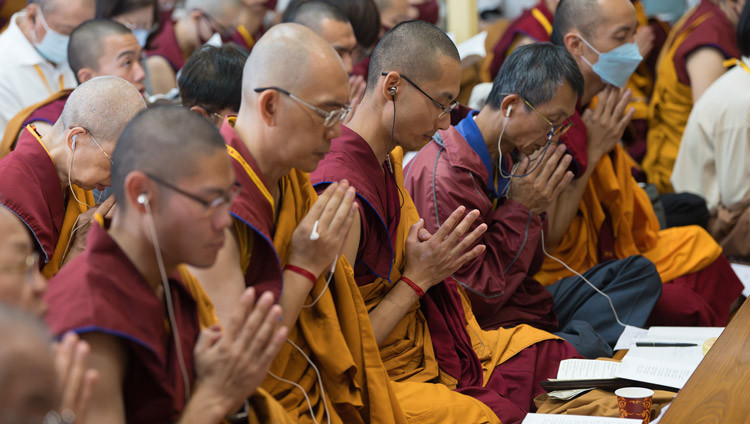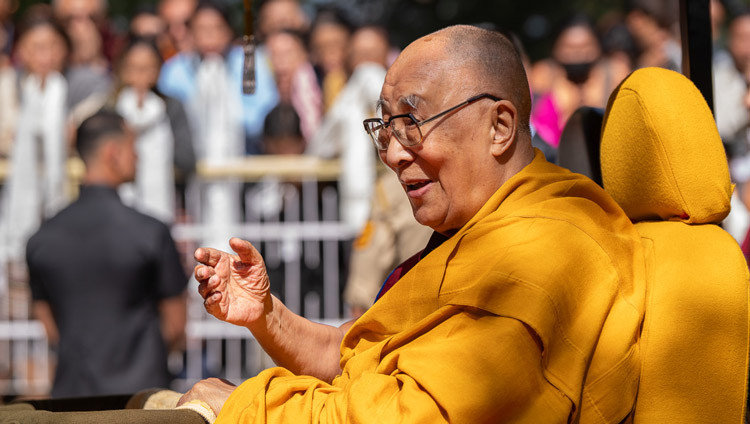Thekchen Chöling, Dharamsala, HP, India - The Dhauladhar mountains stood stark against the clear blue sky this morning as His Holiness the Dalai Lama drove to the lower door of the lift at the Tsuglagkhang, the Main Tibetan Temple. He took time to survey the faces of people in the crowd estimated to number 5800 including 1300 from Taiwan. Many of them smiled back, while others were moist eyed, as he smiled and waved to them.

As soon as His Holiness had taken his seat, two Taiwanese monks led a recitation of the ‘Heart Sutra’ in Chinese. After that a mandala was offered along with representations of the body, speech and mind of the Buddha.
“All of us are equal,” His Holiness began, “in that we all want to be happy and none of us wants to suffer. And we’ve gathered here to listen to how we might fulfil that goal. There are many religious paths in the world, but in Tibet we follow the Nalanda Tradition and study the works of masters such as Nagarjuna and Asanga, and their followers.
“As far as I’m concerned, I was born in the Kumbum region of Dhomé, and, after being recognized as the reincarnation of the Dalai Lama, came to Lhasa where I studied with my tutors Ling Rinpoché and Trijang Rinpoché. I memorized the root texts of the five major topics, then read and listened to the great commentaries that explained them. The tradition of Buddha Dharma that we uphold is unique in that it follows reason and logic. It also includes intricate explanations of the workings of our minds and emotions. This is the tradition we have purely preserved.
“Today, people from the West who have no historical connection to the Dharma, are taking an interest in our tradition. There are even scientists among them who are particularly keen to know more about the mind and emotions. All of us here today are followers of the Buddha and the 84,000 heaps of his teaching, which I consider to be like treasure.
“Since I began my Buddhist education as a child I have studied the Perfection of Wisdom, the philosophy of the Middle Way, Logic and the Theory of Knowledge, Higher Knowledge and Monastic Discipline. From the beginning I engaged in debate based on what I’d learned from the Logic Primer. This approach, employing scrutiny and analysis, is very effective in helping us really understand what the Buddha taught.
“In addition to a detailed account of the workings of the mind and emotions, Tantra presents a further profound explanation of consciousness, including the varying subtlety of different states of mind.

“In a Buddhist context we talk about concern for all sentient beings, but the Tibetan people are those with whom I have a special connection. I intend to continue to serve them as best I can. Although the Chinese communists continue to rule in Tibet, a growing number of Chinese people are taking an interest in Buddhism and the Nalanda Tradition. Historically China was a Buddhist land and it seems that Buddhism may yet be reestablished there. I’ve done what I could to encourage this possibility and will continue to do so for the rest of my life.”
His Holiness announced that he would conduct the ceremony for cultivating the awakening mind of bodhichitta and taking the bodhisattva vows. He advised his listeners to imagine the Buddha, his seven successors, Manjushri, Maitreya and the great masters of India and Tibet in front of them. Then there was a recitation of the seven limb prayer followed by the verses for taking refuge and aspiring to achieve enlightenment, which he asked the disciples to recite three times after him.
I seek refuge in the Three Jewels;
Each and every wrongdoing I confess.
I rejoice in the virtues of all beings.
I take to heart the state of Buddhahood.
I go for refuge until I am enlightened
To the Buddha, the Dharma, and the Supreme Assembly,
In order to fulfil the aims of myself and others
I develop the awakening mind.
Having developed the aspiration for highest enlightenment,
I invite all sentient beings as my guests,
I shall enact the delightful supreme enlightening practices.
May I become a Buddha to benefit all sentient beings.
His Holiness told the audience that he was not especially enthusiastic about the Buddha’s teachings when he was very young. However, as he has grown older, he has come to appreciate how beneficial practices for transforming the mind can be. He mentioned that while followers of theistic traditions repose their faith in God, for Buddhists in Tibet and China it’s taking refuge in the Buddha, Dharma and Sangha that is most important. He recalled meeting very devout practitioners when he visited monasteries in Tibet whose faith, he felt, was stronger than his own.

His Holiness remarked that another aspect of the Buddhist tradition is related to karma, all kinds of positive and unwholesome karma we create, as well as the different degrees of subtlety of our minds. He stated that the Buddhist tradition upheld in Tibet was vast and profound — an excellent tradition.
“We all know,” His Holiness continued, “that we draw distinctions between ourselves and others. We think of our tradition as somehow different from theirs. What we should do is to appreciate all religious traditions. It may be that when we analyse other traditions there may be aspects that do not seem to measure up to us, but that’s no reason to challenge them.
“Sincere practice of religion involves disciplining the mind and taming your emotions. As followers of Shakyamuni Buddha, we should respect all religious traditions because they all have the potential to subdue their followers’ minds. This is why it’s important to admire them.
“When I was living under Chinese communist control there were frequently situations that could have made me angry, but then in 1959 I fled Tibet. I have wholehearted appreciation and faith in the Buddhist tradition that enables us to restrain our emotions and transform our minds.
“If you can cultivate a warm heart, as well as bodhichitta, and share this attitude with those close to you, you will feel relaxed and at ease and the people you relate to will be happy too.
“When I was in Beijing, I met Mao Zedong several times and on one occasion he told me in all seriousness that religion is poison. I said nothing, but I felt sorry for him because he had no idea how beneficial spiritual practice can be.”

His Holiness suggested that in addition to repeating the verse for taking refuge in the Three Jewels, the Buddha, Dharma and Sangha reciting mantras can provide inspiration. Consequently, by asking his listeners to repeat after him, he gave oral transmission of some common mantras — Buddha Shakyamuni’s, Arya Tara’s, Avalokiteshvara’s and Manjushri’s. In connection with Om ara patsa na dhi, the mantra of Manjushri, His Holiness disclosed that he was convinced that reciting this mantra and making prayers to Manjushri had helped him improve his intelligence and wisdom. He reiterated that reciting the mantras of Manjushri and Avalokiteshvara can really make a difference.
After giving transmission of the mantra of the Medicine Buddha he noted that people are sometimes concerned that they face obstacles in fulfilling what they want to do and recommended reciting the mantra of Hayagriva. He followed this by reciting the mantra of Guru Padmasambhava. Finally, he observed that most of the people in today’s gathering consider themselves Gelukpas and gave the transmission of the Mig-tse-ma verse in praise of Jé Tsongkhapa.
You are Avalokiteshvara, great treasury of objectless compassion
you are Mañjushri, embodiment of stainless wisdom;
you are Vajrapani, destroyer of all dark forces;
Tsongkhapa, Losang Drakpa, crown jewel among the learned of the Land of Snows, I pray at your feet.
The chantmaster then brought the session to a close by leading a rendition of 'The Song of Immortality — The Extensive Prayer for the Long Life of His Holiness the Dalai Lama' by his two Tutors, Ling Rinpoché and Trijang Rinpoché. His Holiness left the temple and as he walked to the lift smiled at all the well-wishers who lined the path trying to catch his eye. Reaching the temple courtyard he climbed into a golf-cart to ride back to his residence.












